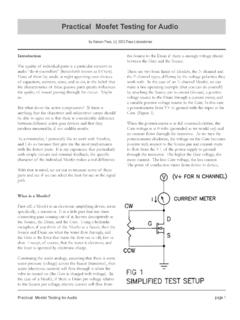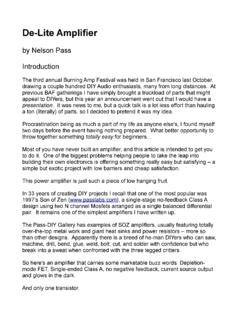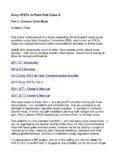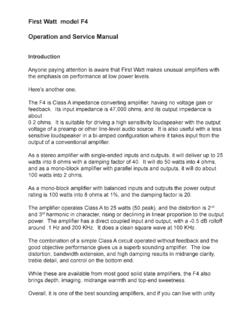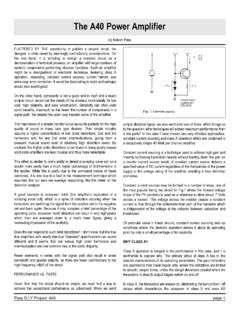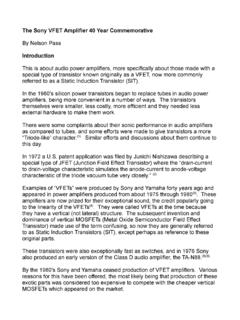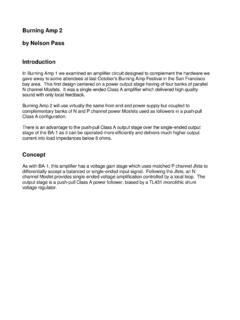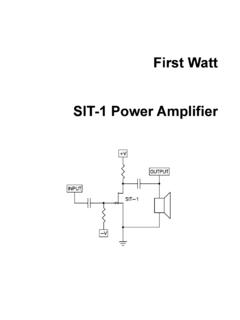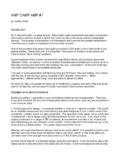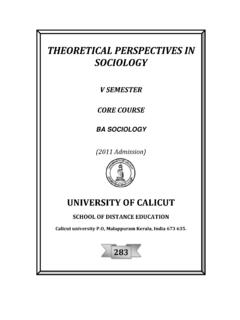Transcription of Arch Nemesis - FIRST WATT
1 arch NemesisBy Nelson PassIntroductionA poster of Einstein once said, Things should be made a simple as possible, but no simpler . This can apply to audio amplifiers, but if they are evaluated subjectively, the simplicity thing can get a little of of hand. Of itself, minimalism exerts a strong aesthetic attraction, and there is a reasonable belief that fewer components in the signal path allows more information to get through with less like me you are interested in understanding of how we hear distortions with our brains (instead of our meters), you might appreciate that simple circuits help isolate these phenomena.
2 I listen to all sorts of flawed circuits because I enjoy hearing the differences, and it helps to train my ears. In this regard, reducing the number and types of flaws makes it easier to tweak a single parameter and hear the difference. I think it's also true that simple distortions are often more forgivable in a listening situation and create less NemesisIn 1985 Jean Hiraga wrote an article in two parts presenting, among other things, a design for a very simple Mosfet amplifer called the Nemesis . Subtitled An Homage to the WE 25 B , the piece celebrated classic simplicity in amplifier design, specifically a Western Electric amplifier that used a single gain triode driven by an input transformer and driving an output transformer, as shown (simplified) in Figure also discussed a 1982 amplifier apparently done as an application note for Siliconix using the VN64GA N channel power Mosfet driven by a J106 Jfet shown in Figure went on to simplify this circuit by eliminating the input Jfet, driving the Gate of the power Mosfet directly (Figure 3).
3 A second version had an interesting connection from the Source of the transistor to the secondary winding, providing both feedback for the transistor and some auto-former support to the output secondary (Figure 4).But Part 2 of L'amplificateur N m sis showed the final schematic where the transistor feedback connection to the secondary winding was dropped, the simplified circuit reverting back to Figure 3. It appears that he was more interested in the sound without the feedback, even though the measured performance 1994 I played with similar concepts in the Zen Amplifier (Figure 5) and followed up with a series of variations on the theme which explored single-transistor designs, some with feedback and some without, but none of them employing output transformers.
4 These articles can be downloaded from At the time I was solely interested in the performance obtainable from single Class A gain stages alone and didn't want to also consider the additional distortions of passive components (including transformers) in the signal there was another reason for not using transformers in the Zen amplifiers - the power Mosfets involved are already pretty happy at the voltages and currents needed by loudspeakers. Tube circuits operate at higher voltages and lower currents by a factor of about 10, so tube power amplifiers really need a transformer to efficiently transform signal energy to higher current and lower voltage when it comes to driving 8 Zen amplifier philosophy ( What is the sound of one transistor clapping?)
5 Calls for a minimum of parts. A component has to be needed to be included, but if you alter the need criterion from measuring better to sounding better then a potentially different perspective opens is a common belief among audiophiles that measurements don't correlate all that well with subjective experience This is not very surprising the ear/brain is immensely complicated, and there are many experiments to demonstrate that our understanding of hearing is not much better than our understanding of consciousness, which is not good. Simply the fact that different cultures and individuals hear known audio illusions differently gives us a clue while making the problem seem more intractable.
6 I don't expect it to be well understood in my objectivists think that audiophile subjectivism is delusional, and they are often right, but that doesn't mean that people hear the same way as test equipment. In the FIRST half of the 20th century, there was a reasonably clear association between measured performance and perceived performance, but probably this was due to the rather high distortion of early equipment, where 1% distortion was considered quite good. These days it's common to see amplifiers measuring .001% or even less, but the audio marketplace doesn't seem to particularly reward such to our of the charms of simple circuits is that they have a better correlation between objective (measured) and subjective (heard) performance.
7 It seems that a simple circuit that measures good is more likely to sound good than a complicated circuit that measures good. Moreover, It appears that simple amplifiers like Nemesis and the Zen make it easier to hear differences between single components and compare these subjective differences to measurements. So Why an Output Transformer?All components have distortion. We can rank them pretty easily based on simple measurements like THD (total harmonic distortion) and variations they cause in frequency response. Wire and resistors are at the top of the list because as a rule they measure quite low.
8 Next are the capacitors, which give us low but easily measured distortions. At the bottom are active gain devices such as tubes and transistors. And transformers don't tend to get a lot of respect from objectivist solid state guys due to bandwidth and distortion issues. You can build a good transistor amplifier without them, and so most do. But Hiraga was (is) not a fool, and in addition there is a small audio cult that likes transformers, even when they aren't essential. They use them for output coupling, input coupling, volume controls and passive crossovers. These are often the same people who disdain capacitors with nearly the same emotion they reserve for MP3 's wrong with these people and what is it with transformers?
9 Jan Didden's NemesisWho knows what's wrong with Jan? Whatever it is, apparently he addressed it by building himself a copy of the Nemesis . I heard about it because he also seems to have wanted to make more of them and talked to Jack Elliano at about getting some transformers made. Ultimately he decided that shipping to Europe was too expensive - did anyone on the forum at want to take up the project? ..That would be have spent quality time with coupling transformers before, but I had never really warmed up to them, possibly because I had not yet reached the 10,000 hour level of listening required to achieve audiophile expertise.
10 In any case, a couple years ago I began experimenting with transformers to solve some problems in a couple of future Zen amplifier projects, and got some fairly good results (good enough for Zens, anyway). Having worked out some circuits, I acquired an assortment of transformers and began evaluating their performance with an eye toward picking the best one. They represented a wide range of cost and materials, and some clearly measured better than others, but when I listened to them I found myself drawn to the sound of one that didn't measure so well. The dissonance that measures bad/sounds good created called for an unbiased test.
